Quick Answer
Advertisers use testimonials as compelling proof of their product or service’s value. They build trust, offer social validation, and resonate with the target audience’s experiences. This social proof strategy consistently boosts credibility and drives results in advertising campaigns.
Ever wondered why successful advertisers often showcase customer testimonials?
It’s more than just positive affirmations; it’s a strategy with a hidden power. As both an online shopper and seasoned digital marketer, I’ve witnessed firsthand the impact testimonials can have online, especially on advertising success.
In this article, we’ll explore the untold secret behind why advertisers, particularly savvy entrepreneurs and business owners, leverage testimonials to elevate their campaigns.
It’s a game-changer, and by the end of this journey, you’ll have a clear understanding of the significant role testimonials play in the advertising landscape.
What Are Testimonials?
Testimonials are powerful endorsements from satisfied customers that vouch for your product or service.
In simple terms, they’re like digital high-fives sharing positive experiences. For all businesses, testimonials serve as valuable trust signals.
When you showcase real experiences from happy customers, you’re building credibility and making it easier for others to trust and engage with your offerings.
Why Do Advertisers Use Testimonials: The Benefits
1. Leverage the power of social proof
When your audience sees real people endorsing your product or service, it creates a powerful affirmation. It’s like saying, “Look, others have tried it, loved it, and you can too.” This genuine support fosters trust and makes the decision-making process smoother for your audience. It’s a persuasive tool in your advertising arsenal, ensuring your brand stands tall in a sea of choices.
2. Create an emotional connection
Testimonials build emotional bridges connecting your brand with your audience. They help establish a genuine connection.
When potential customers read or hear about real experiences, it humanizes your brand. These shared stories evoke emotions, resonating with the aspirations and challenges of your audience. By weaving an emotional connection through testimonials, you’re not just selling a product; you’re inviting people into a community of shared experiences, making your brand memorable and relatable.
3. Establish credibility and trust
Credibility is your currency.
In the competitive landscape of business, testimonials emerge as your trust-building champions. Testimonials, backed by real experiences, validate your claims and establish a trustworthy reputation. When potential customers hear directly from satisfied clients, it adds a layer of authenticity that can’t be replicated by traditional marketing.
Your audience is looking for reliability, and testimonials serve as tangible proof that you deliver on your promises, laying a solid foundation of trust in your business.
4. Increase conversion rates and sales
When prospects see the positive experiences of others, it’s a compelling nudge toward making a purchase or taking the desired action.
This tangible proof serves as a powerful persuader, minimizing doubts and encouraging your audience to follow in the footsteps of those who have already experienced the benefits of your products or services. It’s a conversion-boosting strategy that can’t be overlooked.

5. Build a positive brand image
Stories from satisfied customers paint a vivid picture of your brand’s excellence. When shared experiences highlight your strengths, it creates a positive narrative.
For your audience, this isn’t just about a product; it’s about aligning with a brand that consistently delivers value and satisfaction. Testimonials contribute to a favorable perception, shaping your brand into one that resonates positively in the minds of potential customers.
6. Differentiate yourself from competitors
In a crowded marketplace, standing out is a challenge, but testimonials provide the differentiator you seek. Testimonials showcase your distinct value proposition.
When potential customers compare options, real experiences from satisfied clients become the deciding factor. It’s not just about what you offer; it’s about the exceptional experiences others have had with your brand. Testimonials become your competitive edge, setting you apart in a sea of choices and guiding customers toward choosing you.
7. Address Customer Concerns
Testimonials, by showcasing positive experiences, directly speak to potential worries. Whether it’s about product effectiveness, customer service, or delivery, real stories from satisfied clients act as a beacon of assurance. They offer practical insights, dissipating doubts and showcasing your commitment to customer satisfaction. Testimonials, in this context, become a valuable tool in your arsenal, effectively addressing and mitigating concerns that might hinder conversions.
Social Proof Examples In Different Industries
1. Ahrefs
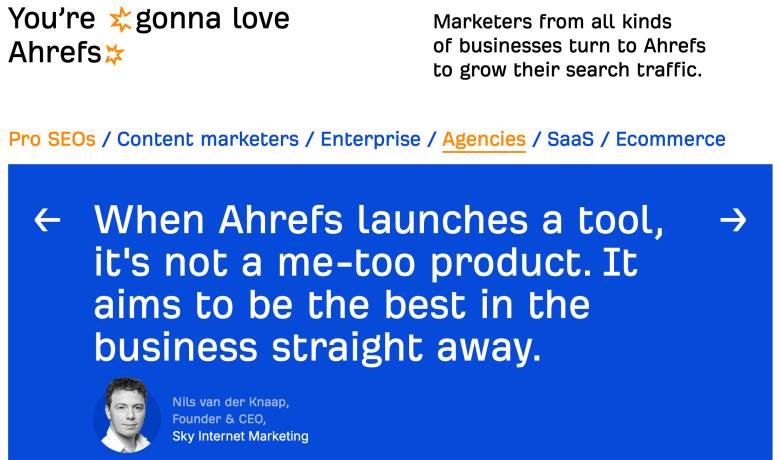
Ahrefs leverages testimonials on their homepage. These reviews are highlighted in a big block with their brand colors. They also make the most of the space by providing a single review at a time and separate them by industries. This way they can demonstrate their impact on content marketing, agencies, SaaS, and ecommerce.
2. BeforeSunset
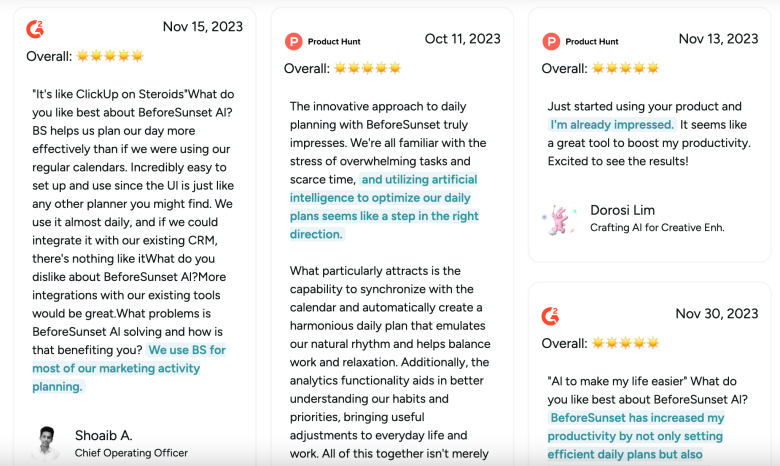
BeforeSunset displays trustworthy testimonials on their homepage. They have opted for including a link directly to where the review is found online. This is a great strategy because it demonstrates truthfulness and shows the source of their review.
3. SketchWow
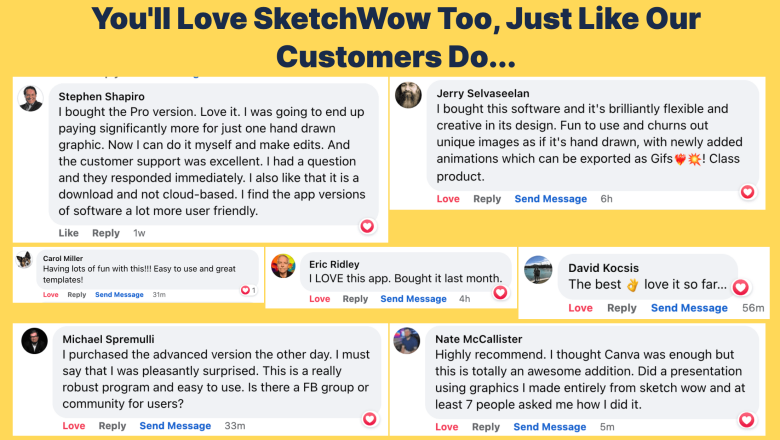
Sketchwow displays their social media testimonials on their homepage, which also serves the purpose as their main landing page to promote their lifetime deal. Since SketchWow is a design tool, having testimonials about their practicality and functionality features is pivotal to attract new users.
4. Coaching Program by Miles Beckler

In this case, we have a high-ticket coaching program with multiple free bonuses. Since high-ticket products take a longer customer journey for conversion, adding real reviews is oftentimes the tipping point for many customers. Once they see the value brought to similar people, they will want it for themselves as well. On the sales page for this product, you can find these testimonials not once but twice, which mixes it up with the informational details.
5. Atomic Habits by James Clear
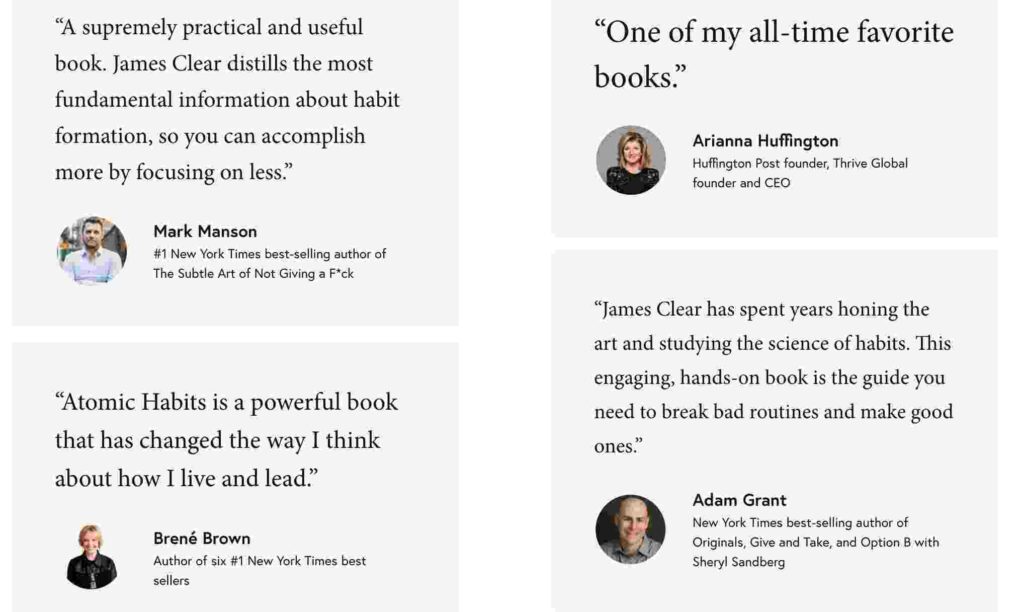
Atomic Habits is one of my favorite books and a best seller that has helped many build new habits. On this site, reviews by other prominent authors and experts are leveraged to demonstrate the value this book has to offer.
These examples demonstrate how testimonials can be leveraged in many industries and for different types of products. In the future, consider adding reviews for your products and/or services. You will see the massive difference it makes on your conversion rates.
In case you don’t have reviews yet, consider sharing your product with a small pool of users in exchange for a testimonial. Keep reading to learn how.
Best Practices For Effective Testimonials
1. Collecting authentic testimonials
Authenticity is the bedrock of trust, and genuine testimonials directly reflect the real experiences of your customers. To ensure authenticity, encourage customers to share specific details about their experiences, emphasizing the tangible benefits they gained. Use varied channels like emails, surveys, or direct outreach to collect these authentic stories.
By valuing and showcasing real voices, you not only build trust but also create a transparent narrative that resonates with your audience, making your brand more relatable and trustworthy.
2. Showcasing testimonials on your website
Place testimonials prominently, ideally on your homepage or product/service pages. Use a mix of written and visual testimonials to cater to different audience preferences. By integrating these real stories seamlessly into your website, you’re not just informing visitors – you’re actively building trust, enhancing your brand’s appeal, and guiding potential customers toward positive action. It’s a simple yet impactful method to infuse authenticity into your online presence.
3. Incorporating testimonials in marketing collaterals
Whether it’s brochures, flyers, or promotional materials, strategically weave in snippets of customer experiences.
Use compelling quotes or brief success stories that align with the specific marketing message. This not only adds a human touch to your collateral but also substantiates your claims with real voices. By seamlessly incorporating testimonials, you’re not just presenting information; you’re building credibility and making a persuasive case for your products or services. It’s a potent way to turn your marketing materials into trust-building assets.
4. Using testimonials in social media marketing
Share snippets of glowing testimonials as posts or incorporate them into visually appealing graphics.
Encourage customers to share their experiences directly on social platforms. This transforms your social media presence into a testimonial showcase, leveraging the power of real voices to engage your audience.
5. Leveraging video testimonials
Capture satisfied customers sharing their experiences on camera. These visual endorsements convey authenticity and emotion in a way that text may not. Use these videos across your website, social media, and marketing campaigns.
Types of Testimonial Advertising
A. Celebrity Endorsements
When a well-known figure vouches for your product or service, it adds a layer of prestige and credibility. Celebrities’ influence can capture attention, build trust, and elevate your brand’s visibility. By associating your brand with a recognizable face, you’re tapping into the positive perceptions and aspirational qualities linked with that celebrity, creating a compelling narrative that resonates with your audience.
B. Influencer Testimonials
Influencer testimonials offer a dynamic approach to amplify your brand’s message. Collaborating with online influencers taps into their established credibility and engaged audience.
These influencers, often seen as trusted voices in specific niches, provide authentic endorsements that resonate with their followers. By aligning your brand with influencers relevant to your industry, you not only gain exposure but also benefit from the trust these influencers have cultivated with their dedicated audience. It’s a strategic partnership that can significantly enhance your advertising efforts.
C. Expert Opinions
By featuring endorsements from industry authorities or experts, you’re infusing your brand with a valuable layer of credibility. These testimonials not only validate your product or service but also position your brand as a trusted source within your field.
When potential customers see respected figures endorsing your offerings, it instills confidence and reinforces your brand’s authority. It’s a strategic play that adds depth and authenticity to your testimonial arsenal.
D. User-Generated Content
User-generated content (UGC) is a valuable asset in the realm of testimonial advertising. Encouraging your customers to create and share their own content, such as reviews, testimonials, or photos, adds an authentic touch to your brand.
As users share their genuine experiences, it creates a community-driven narrative. UGC not only serves as social proof but also fosters a sense of belonging among your audience. This organic, user-driven approach has proven to be a compelling and trustworthy way to showcase the positive impact of your products or services.
D. Case Studies
Delving deeper into success stories, case studies provide a comprehensive view of how your product or service addresses specific challenges. By presenting detailed narratives, potential customers gain insights into real-world applications and outcomes.
Case studies go beyond a simple endorsement, offering a thorough exploration of the value you bring. As a result, they become powerful tools for building trust, demonstrating expertise, and showcasing the tangible benefits your offerings bring to the table.
How To Incorporate Testimonials In Your Advertising
Incorporating testimonials into your advertising strategy is a nuanced art that every entrepreneurs and business ownercan master.
- Start by strategically placing compelling snippets on your website, prominently visible on key pages.
- Use testimonials in your marketing collaterals, weaving them seamlessly into brochures, flyers, and promotional materials.
- Embrace the dynamic power of video testimonials for a personal touch that resonates.
- Leverage the influential potential of social media by sharing testimonials as engaging posts.
By implementing these practices, you’re not just showcasing positive feedback – you’re crafting a narrative that builds credibility, trust, and resonates with your audience, ultimately enhancing the effectiveness of your advertising efforts.
FAQs
What are the benefits of testimonial advertising?
Testimonial advertising provides social proof, building trust and credibility. It emotionally connects with your audience, differentiates your brand, and, ultimately, drives conversions and sales by showcasing real experiences.
Why is the testimonial technique used in advertising?
Testimonials leverage real customer experiences to validate claims, building credibility and trust. This technique persuades potential customers, creating an emotional connection and influencing their purchasing decisions.
Video vs Text Testimonial: Which one Wins?
Both video and text testimonials are powerful. Videos add a personal touch with emotions and expressions, while text testimonials offer quick, easily digestible information. The preference mainly depends on your audience, the story you want to tell, and the platform you’re using (YouTube, TikTok, LinkedIn, your own website, etc.)
Keep in mind that the trend in most platforms is that short-form video is easily consumed and attention-grabbing for most audiences.
How do I get as many testimonials as possible from customers?
Encourage satisfied customers to share their experiences through emails, surveys, or direct outreach. Offer incentives, make the process simple, and showcase the value their testimonials bring in building trust.
What Types of Testimonials Are There?
Testimonials come in various forms, including written testimonials, video testimonials, celebrity endorsements, influencer testimonials, expert opinions, user-generated content, and case studies. Each type adds a unique dimension to your advertising strategy.
The Bottom Line
Testimonial advertising is a transformative strategy for entrepreneurs. From fostering trust through social proof to deploying diverse testimonial types, you’ve gained a powerful toolkit.
Embrace written and video testimonials, collaborate with influencers, and leverage expert opinions. Now, empower your advertising efforts by weaving these authentic narratives into your assets.
Witness firsthand the impact of real experiences on brand credibility and customer connection. By incorporating testimonials strategically, you not only stand out in the market but also create a compelling story that resonates with your audience, fostering lasting relationships and driving business success.
Final tips:
Utilize diverse testimonial types and best practices to empower your brand. Incorporate testimonials into your assets, leveraging real experiences to connect with your audience.
Witness firsthand how this simple yet potent strategy elevates your advertising game and strengthens your brand’s credibility.

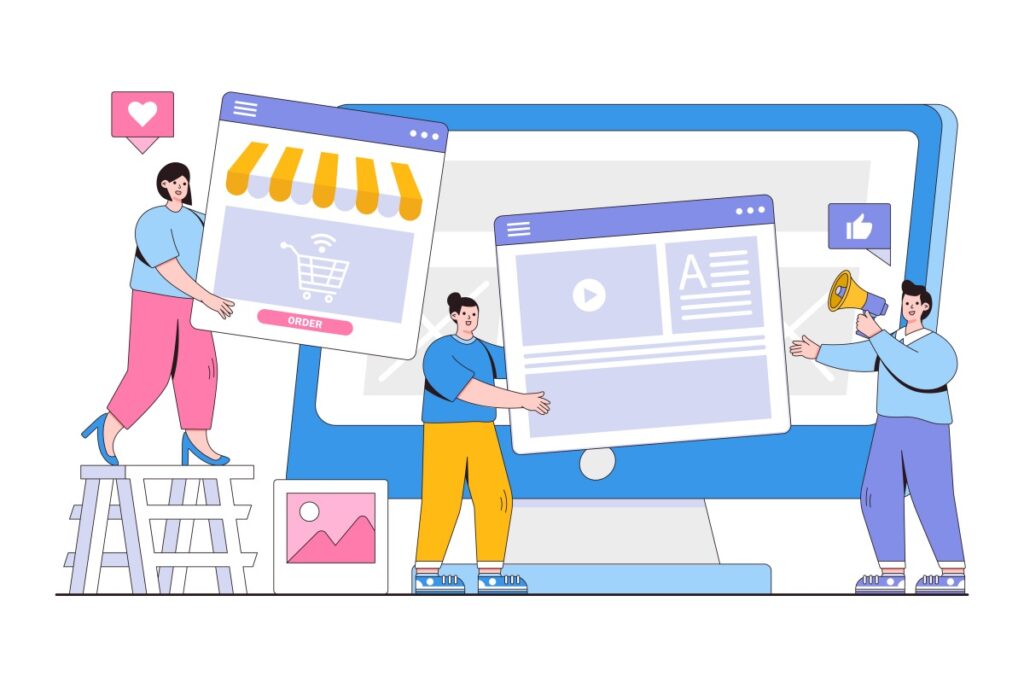




It’s going to be ending of mine day, except before
ending I am reading this impressive piece of writing to increase my knowledge.